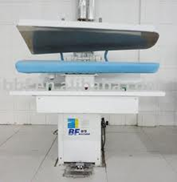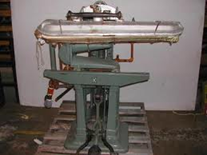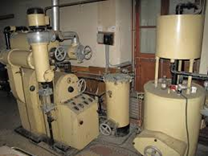History of Drycleaning
![]()
Drycleaning is the process of washing fabrics with a liquid other than water. Drycleaning solvents dissolve oils and fats which are not water soluble. These solvents do not swell natural fibres as does water, one of the major causes of shrinkage.
Archeological discoveries have revealed the existence of "drycleaners" in the Mycean Period (16-1200BC). However, modern cleaning was not known until the birth of the chemical industry in the 1800s.
Legend says drycleaning began in France in the 1840's with an accidental discovery that camphene turpentine spirits, a lamp fuel, had excellent cleansing powers. The accident involved a maid or quarrelling lovers who tipped over a lamp onto a soiled table cloth - - when the cloth dried, the soil was gone.
Spirits of turpentine had long been known as a good spotting agent for grease stains. In 1690 an anonymous writer said, "oil of turpentine will make rosin crumble away". In 1716 a French book entitled "Secrets Concernant les Arts et Metiers" describe a "special secret for removing grease and oil spots from silk stuff". It said "one rubs the spots on the silk with the spirits of turpentine, this spirit evaporates and take with it the oil in the spot".
The transition among cleaners in the mid 1800's from the spot cleaning to total "drycleaning" was not rapid. At lease not until the more enterprising leaders of the craft showed by their successes that solvent immersion cleaning was indeed a new and profitable technique.
Some of the incentives were:
-
Garments could be cleaned whole without dismembering them as was the custom in wet cleaning methods.
-
The time it took to perform the cleaning process was very much reduced, affording further savings in labour.
-
Fugitive colours and finishing agents were not affect or removed by solvent as they were with water.
-
Pressing or finishing operations were much easier to carry out.
All accounts credit the cleaning and dyeing firm of J B Jolly in Paris with being the leading proponent of the new solvent immersion system - a business that grew out of the dyeing establishment founded in 1794.
It is unknown how long camphene or benzene remained as a drycleaning solvent, but a third kind of organic solvent became available in the 1800s. It grew out of the great industrial developments which took place in the United States after Alfred Gesner's discovery in 1852 in Ontario, Canada, of a map fuel he called kerosene and derived from crude Petroleum.
Later a "useless' by-product of kerosene refining called petrol found a small market among dyers and scourers in the United States who were just beginning to turn solvent immersion techniques introduced in Europe
Petrol was the main solvent used in the United States in the early twentieth century. But petrol and other petroleum derivatives used in drycleaning were highly flammable and explosive. From 1921 to 1925 research was conducted in the United States and the National Institute of Dyers and Cleaners, now know as the International Fabricare Institute (IFI), adopted standards for a dry solvent which had a flash point of 100F.
The solvent was named Stoddard Solvent in honour of the Institute's President, W J Stoddard, who had been a prime mover in developing a safer solvent. This solvent is also known as white spirits in Australia and was the petroleum spirit used extensively until the development of synthetic solvents in the 1970s.
Perchioroethylene or 'perc' is the principle synthetic solvent used by today's professional drycleaner. It is completely non-flammable and has greatly helped the growth of drycleaning plants into well populated areas such as shopping centres and housing developments.
Most of the drycleaning plants in Australia use synthetic solvents (perc being the most popular) although some petroleum base solvents are still used.
Flurocarbon type drycleaning solvent was introduced to Australia in the early 1990s but was outlawed in 1997.
Newer solvents being introduced into Australia include hydrocarbon and Greenearth and these are finding a loyal following amongst drycleaners.





